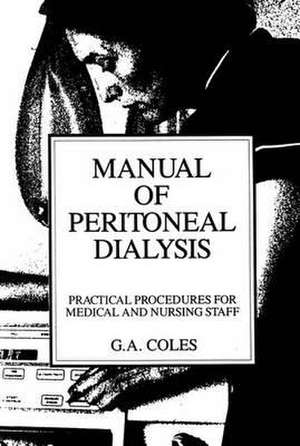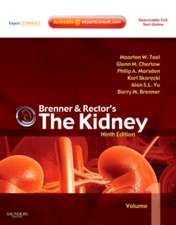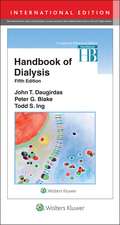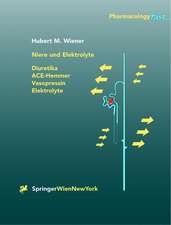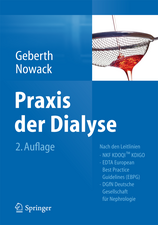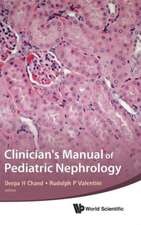Manual of Peritoneal Dialysis: Practical Procedures for Medical and Nursing Staff
Autor G.A. Colesen Limba Engleză Paperback – 31 mai 1988
Preț: 706.60 lei
Preț vechi: 743.79 lei
-5% Nou
Puncte Express: 1060
Preț estimativ în valută:
135.27€ • 141.14$ • 113.39£
135.27€ • 141.14$ • 113.39£
Carte tipărită la comandă
Livrare economică 12-26 martie
Preluare comenzi: 021 569.72.76
Specificații
ISBN-13: 9780746200810
ISBN-10: 0746200811
Pagini: 128
Ilustrații: 128 p. 4 illus.
Dimensiuni: 155 x 235 x 7 mm
Greutate: 0.19 kg
Ediția:Softcover reprint of the original 1st ed. 1988
Editura: SPRINGER NETHERLANDS
Colecția Springer
Locul publicării:Dordrecht, Netherlands
ISBN-10: 0746200811
Pagini: 128
Ilustrații: 128 p. 4 illus.
Dimensiuni: 155 x 235 x 7 mm
Greutate: 0.19 kg
Ediția:Softcover reprint of the original 1st ed. 1988
Editura: SPRINGER NETHERLANDS
Colecția Springer
Locul publicării:Dordrecht, Netherlands
Public țintă
ResearchCuprins
Section A — Temporary Peritoneal Dialysis.- Choice of cannula.- Trolley setting for cannulation.- Cannulation for the nurse.- Insertion of cannula.- Removal of old cannula.- Cannula replacement.- Daily dressing.- Special nursing care.- Bag change.- Emptying drainage bag.- Cannula disconnection.- Cannula reconnection.- Bloodstained fluid.- Haematoma of abdominal wall.- Perforated bladder.- Perforated bowel.- Pain in the abdomen.- Fluid will not run in.- Fluid is slow running in.- Fluid will not run out.- Fluid is slow to run out.- Flushing cannula.- Use of urokinase.- When to sample.- Sampling of fluid.- Crusting around cannula.- Redness around cannula.- Infection around cannula.- Leakage from old site.- Leakage around cannula.- Leakage from tubing or cannula.- Cannula disappears.- Cannula moves out.- Cloudy fluid.- Peritonitis.- Antibiotic dosage.- Notes on aminoglycosides.- Prophylactic antibiotics.- Faeculent fluid.- Multiple organisms.- False positive cultures.- Fluid balance assessment.- Fluid removal.- Failure to remove excess fluid.- Oedema of abdominal skin.- Oedema of genitalia.- Dehydration.- Hypotension.- Hypertension.- Ascites.- Hypoalbuminaemia.- Obesity.- Dialysis after laparotomy.- Ileus, obstruction, adhesions.- Colostomy, ileostomy, ureterostomy, conduit.- Abdominal fistulae and drains.- Blood urea does not fall.- Disequilibrium.- Hyperkalemia.- Hypokalemia.- Hyperglycaemia.- Hypercalcaemia.- Chest complications.- Air under diaphragm.- Hernia.- Choice of cycle volume.- Dwell times.- Continuous or intermittent dialysis.- Choice of fluid.- Heating of fluid.- Automatic machines.- Section B — Long-Term Peritoneal Dialysis.- Selection of cannula.- Trolley setting for catheter insertion.- of Silastic catheter set.- Insertion of catheter.- Alternativesites.- Laparoscopic placement.- Dialysis after catheter insertion.- Alternative procedure.- Exit site care.- Cannula removal.- Replacing catheter.- Pre-peritoneal placement.- Changing the bag — general.- Changing the bag — (Baxter spike system).- Alternative bag change — (Baxter system II).- Baxter UVXD bag change.- O set bag change.- Freeline.- Changing the tubing.- CAPD line change (Baxter system).- Choice of tubing.- Adding medication to CAPD fluid.- Sampling.- Use of heparin.- Fibrin in fluid.- Flushing cannula.- Use of urokinase.- Pain in abdomen.- Bloodstained fluid.- Yellow or orange fluid.- Leakage of fluid.- Fluid leaks through the vagina.- Crusting around cannula.- Cuff erosion.- Exit site infection.- Tunnel infection.- Cannula appears through skin.- Cloudy fluid.- Peritonitis.- Relapsing peritonitis.- Antibiotic dosage.- Presence of cells in the dialysate.- Contamination accidents.- Cracked or distorted connecter.- Split cannula.- Re-use of catheter components.- Fluid will not run in.- Fluid will not run out.- Rotation of a faulty catheter position.- Cannulogram.- Fluid balance.- Failure to remove excess fluid.- Hydrothorax.- Oedema of abdominal wall or genitalia.- Hypotension.- Hypertension.- Dialysis with a stoma.- Peritoneal adhesions and sclerosis.- Insertion via laparotomy.- Dialysis after laparotomy.- Hypokalemia.- Obesity.- Lack of subcutaneous fat.- Backache.- Temporary stopping.- Hernia.- Baths, showers, swimming.- Use of insulin.- How many cycles?.- Choice of volume.- Choice of antiseptic.- Heating the fluid.- Suggested Further Reading.
